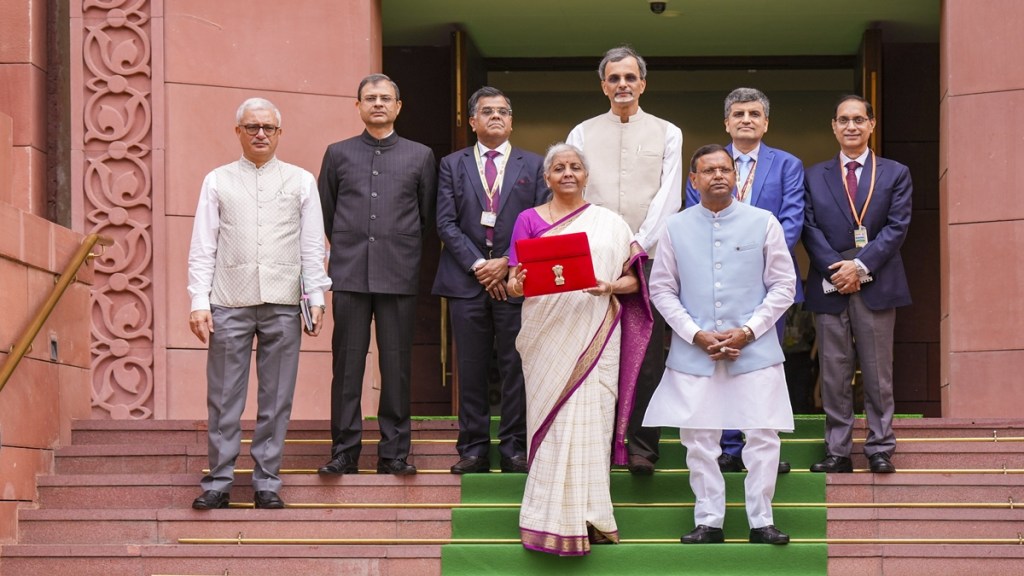This is a first take on the Budget, without a detailed scrutiny of the voluminous Budget documents. I assess the Budget through a lens consisting of three factors. First, is the fiscal stance of the Budget appropriate for the present macroeconomic context? Second, the outcome of the May elections has important political implications for the Budget; how have these been addressed? Third, this is the first of five Budgets through which the present government will set the course for Viksit Bharat, India’s aim of becoming a developed country by 2047. How has this long-term goal been addressed?
On the first question, despite a challenging external environment, India’s macroeconomic position is very comfortable. With sustained annual growth of 7% or more, it is the fastest-growing major economy globally. Inflation remains moderately elevated mainly on account of high food price inflation, still above the Reserve Bank of India’s (RBI) 4% target but within the 5% ceiling of its tolerance band.
The current account deficit is also very comfortable at less than 1%. In this macroeconomic context the fiscal stance of the Budget seems just right, following Nirmala Sitharaman’s now well-known fiscal approach: High public capex to lead growth; this combined with fiscal consolidation, progressive reducing of the fiscal deficit; meeting this dual goal by containing revenue expenditure within limits as enabled by revenue growth.
All three features are prominent in today’s Budget. There is again a large increase in capital expenditure, amounting to over `11 trillion, or 3.4% of GDP. The zero interest, 50-year capex loan scheme for states has also been retained and expanded. Despite this, the fiscal deficit has been budgeted at 5.1% of GDP, a sharp reduction from 5.9% last year. This assumes robust revenue growth of 14.7%, which in turn assumes buoyant tax revenue growth in addition to the large transfer of the RBI surplus.
Meanwhile, revenue expenditure growth has been budgeted to grow by only 6.2%, especially compressing traditional safety net projects, thereby leading to the sharp deficit reduction.
On the second question — that of the response to election outcomes — the post-mortem made clear that the government has to focus on employment growth. Also, with its reduced majority, the Bharatiya Janata Party-led central government is now heavily dependent on Nitish Kumar and N Chandrababu Naidu, both of whom demanded special category status or special packages for their states, Bihar and Andhra Pradesh. How has the Budget responded to these compulsions?
A host of schemes are aimed at productive employment generation in labour-intensive sectors under four of the nine Budget priorities: agriculture, employment and skilling, inclusive development and social justice, and development of micro, small, and medium enterprises. These have been prioritised over the two traditional pillars of the social safety net, namely food subsidies and the relief employment scheme under the Mahatma Gandhi National Rural Employment Guarantee Act.
The demands of Bihar and Andhra Pradesh have been addressed by a special package for the entire eastern region, covering not just for these two states but also Jharkhand, West Bengal, and Odisha. The package includes road, rail, and power projects. In addition, there are special infrastructure support programmes for Bihar, such as the Kosi flood control project and tourism related projects in Bodh Gaya, Rajgir, and Nalanda.
In Andhra Pradesh, a generous provision has been made for the Amaravati capital project and economic corridor projects from Vijaywada to Chennai and Bengaluru, and schemes for the backward Rayalaseema region.
On setting the course for Viksit Bharat, the schemes for infrastructure development and for productive employment generation, skilling, and promoting labour-intensive sectors will contribute to this long-term goal. But Viksit Bharat will also require significant structural reforms along a wide front. The finance minister indicated that a forthcoming economic policy framework will guide the next generation of reforms. Details are awaited, especially for systematic tax reforms. Some ad hoc tax measures have been announced, such as the elimination or reduction of basic customs duties in indirect takes.
There are also some changes in the personal income tax rates and the tax on short-term capital gains. But the big whammy here is the elimination of indexation in sale of property for tax on long-term capital gains. Hopefully, this will be rolled back. Otherwise, it could play havoc with the property market, with knock-on effects in financial markets and other sectors of the economy.
Sudipto Mundle, Chairman, Centre for Development Studies
Views are personal

